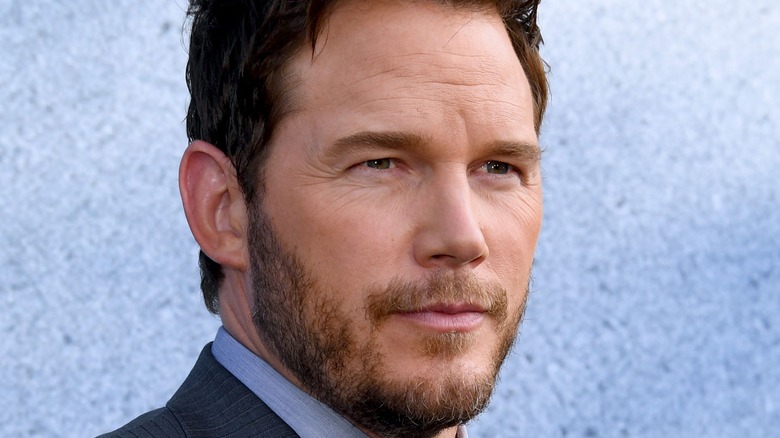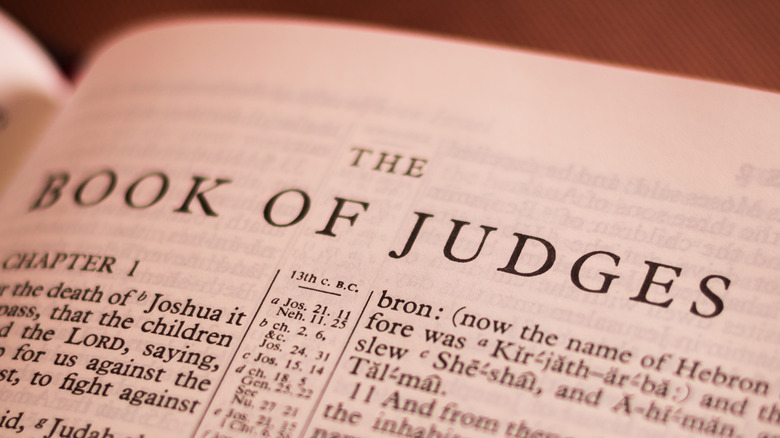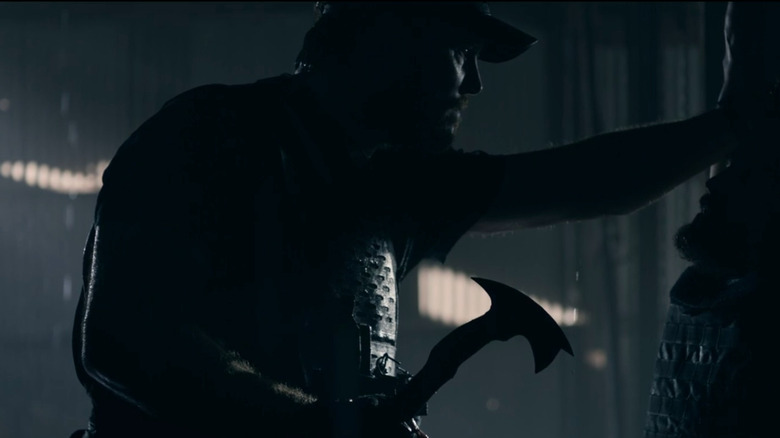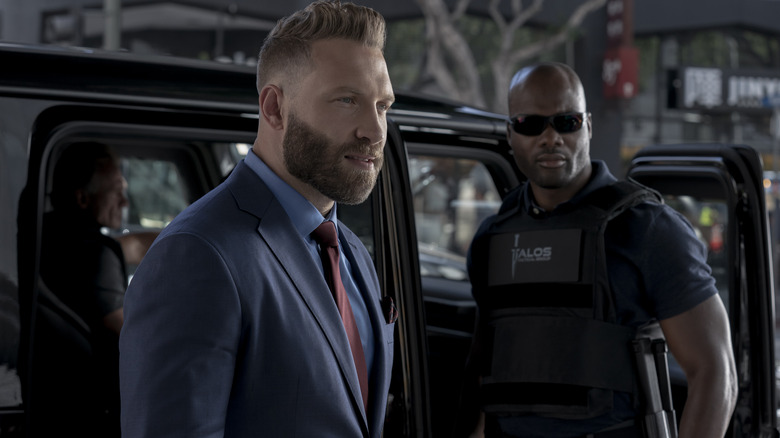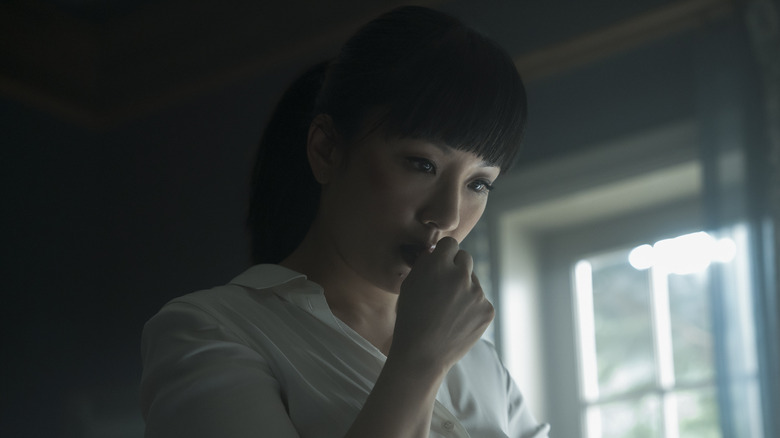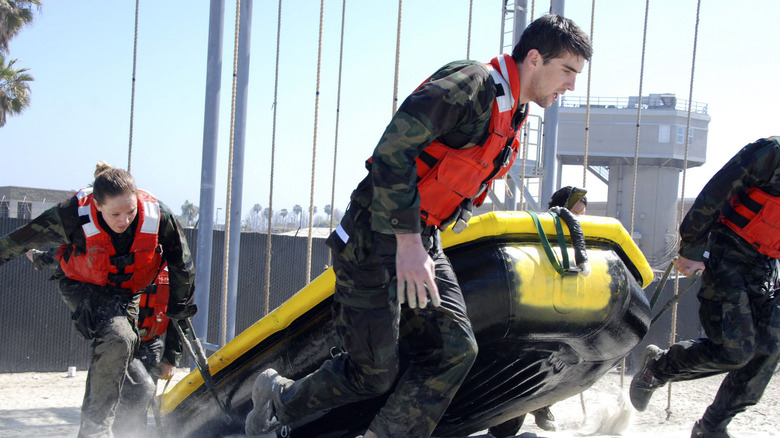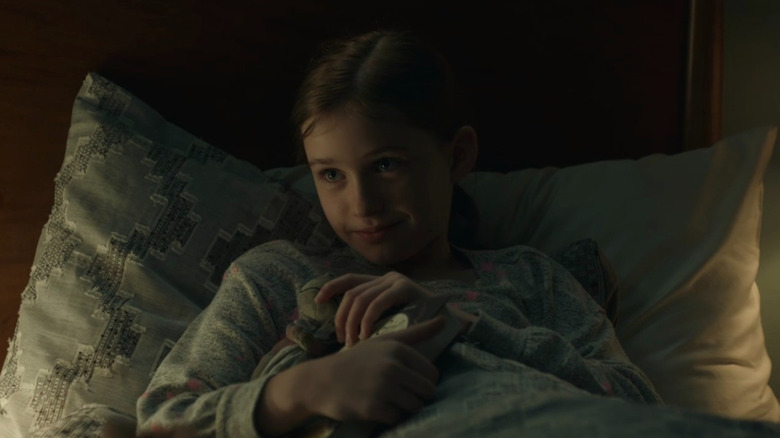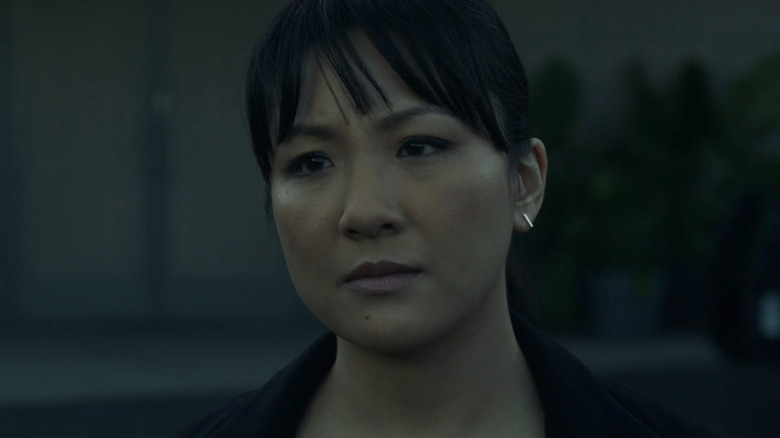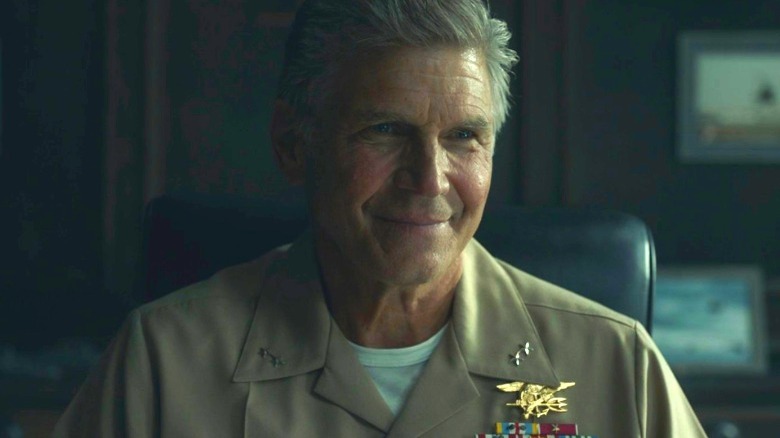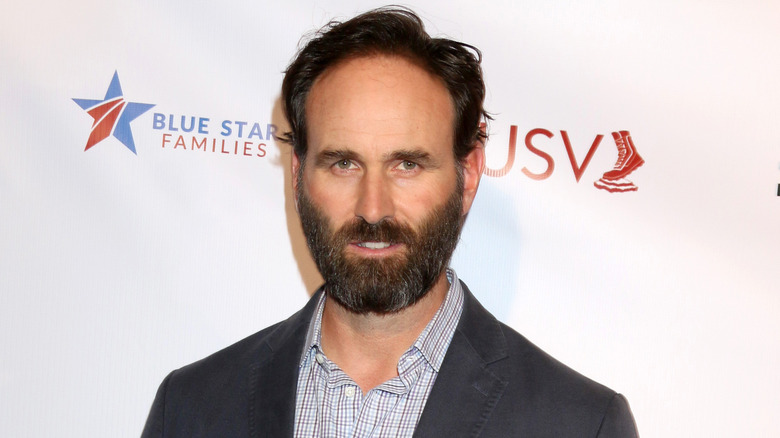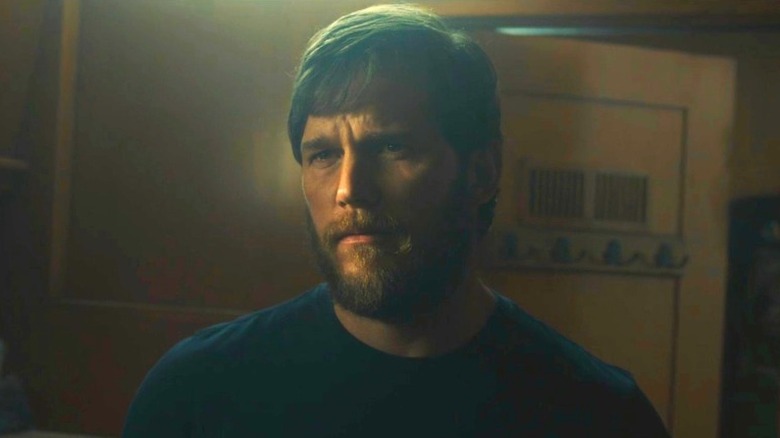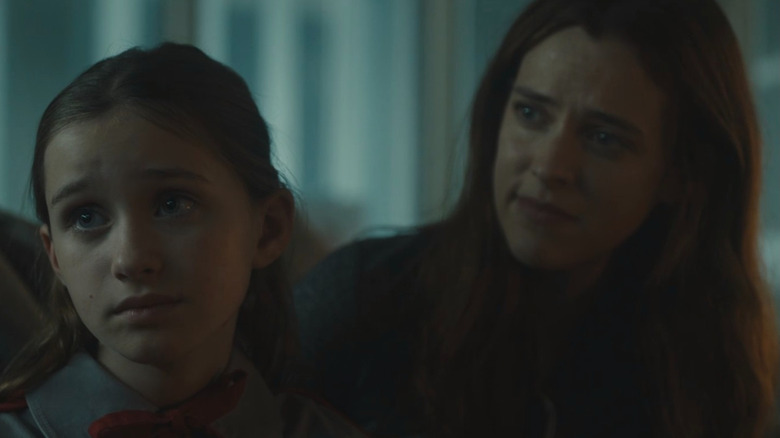Confusing Moments In The Terminal List Explained
A grizzled special forces commando crouches, wounded, under a makeshift shelter in a state park north of San Francisco. Over a stolen radio, he tells the FBI agents pursuing him, "It'd be a mistake to push a man to violence, if violence is what he's dedicated his whole life to perfecting."
Fans who only know Chris Pratt for his comedic work might be surprised to hear a line that sounds plucked straight from Sun Tzu emerging from the mouth of everybody's favorite Pawnee Parks Department employee. But in Amazon's 2022 conspiracy thriller "The Terminal List," Pratt switched gears by taking on the role of Lt. Commander James Reece, a Navy SEAL out for revenge against those responsible for the murders of his entire platoon and his wife and daughter.
Based on the novel of the same name by retired Navy SEAL Jack Carr, the show has divided audiences and critics. Some praised it for its thrilling pace and military accuracy, while others criticized it for its unabashed jingoism and hollow characters.
With its break-neck pace and alphabet soup of military jargon, it can be hard to keep up with the labyrinthine plot of conspiracies and double-crosses. The showrunners do not waste words getting James Reece from action set piece to action set piece and expository scenes are few and far between.
The show has plenty of smaller details that can be difficult to pick up on during a casual viewing, so here are some of the most confusing moments in "The Terminal List" explained.
Warning: This article contains spoilers for Season 1 of "The Terminal List"
What is the significance of the Book of Judges?
If you're looking for good, old-fashioned revenge stories, there few better places to look than the Old Testament. Not surprisingly then, "The Terminal List" kicks off with a reference to the prophet Gideon. The pilot episode contains a verse from the Book of Judges, which describes a test by which Gideon selects the men most fit to wage war.
While there are different translations of Judges 7:4-7 (via Slate), in the version used on the show, Gideon selects the 300 men who kneel to drink from a river, rather than drink on their stomachs. The kneeling men keep their eyes on the horizon and hands on their weapons, waiting for the enemy to appear.
The story of Gideon and his 300 men symbolizes the effectiveness of a smaller, elite fighting force against a numerically superior foe. This idea is central to the formation of special forces units, which "The Terminal List" explores: The Department of Defense replaces larger standing fighting forces with smaller specialized units like James Reece's Navy SEAL unit. This shift results in an increased burden on a small community of already overworked soldiers.
Gideon is also an apt analogy for James Reece and his search for vengeance. After Gideon leads his army of 300 Israelites to victory against the Midianites, he kills the Midianite kings Zebah and Zalmunna, who were responsible for brothers' deaths. Divine retribution delivered by one of the chosen few, motivated by something greater than himself to overcome all odds by sheer force of will. Sound familiar?
What's up with the tomahawks?
Many television shows use the opening credit scenes to pepper in small details that help flesh out the world in which you're about to immerse yourself, and "The Terminal List" is no exception. Its somber opening titles feature several interesting pieces of memorabilia and equipment in James Reece's man-cave/home office.
Perhaps most eye-catching are the crossed tomahawks mounted on the wall above his work bench. When James Reece packs his weapons before leaving home to track down the men responsible for the deaths of his lived ones, the axes come along for the ride and in fact, are used in one of the show's most memorable and grisly killings.
This small detail is probably familiar for people who have read the book on which the show is based. In Jack Carr's novel, tomahawks are Reece's signature weapon and are used to dispatch multiple names on his list. On his website, Carr says that he chose tomahawks because he wanted to indicate that Reece is a "student of war," so fans of the novel will no doubt be thrilled to see that the literary Reece's signature blades have made it into the television adaptation.
What are the companies involved with RD-4895?
The central conspiracy of Season 1 of "The Terminal List" involves the experimental drug RD-4895, which was administered to Reece's unit before the disastrous mission in Syria. Reece discovers that the headaches and memory problems he's been having since the ambush are the result of this mystery drug, which is connected to the shady company Capstone Industries.
RD-4895 was created by the pharmaceutical company Nubellum, led by Mike Tedesco (Paul McCrane). Tedesco originally developed drugs to treat Alzheimer's patients until Nubellum was purchased by Capstone Industries CEO Steve Horn (Jai Courtney). Capstone Industries is a conglomerate with fingers in many pies, including the military industrial complex.
Horn pressures Tedesco to pivot from medical to military applications of drugs. This leads to the creation of RD-4895, which they believe can be used to prevent combat veterans from experiencing PTSD and is potentially worth billions of dollars. Eager to milk this nootropic cash cow, Horn uses his connections in the Department of Defense to bypass FDA regulations on human testing and try out the drug on members of the military.
And he would have gotten away with it if it weren't for those meddling brain tumors caused by RD-4895. With a potential sale to Elias Ryberg's (Carsten Norgaard) company Plano on the line, Horn pays off several officers in Reece's chain of command to send the Alpha Platoon into an ambush in Syria, thus erasing any evidence of the drug's fatal side effects.
Why does Mike Tedesco talk to the press?
Nubellum CEO Mike Tedesco is just another businessman out for a big payday until he has a sudden change of heart in Episode 5. He tries to tank the sale of Nubellum to Plano during a meeting with Elias Ryberg. Later on, he blows the whistle on Capstone Industries and gives reporter Katie Buranek (Constance Wu) damning evidence of the cover-up of Operation Odin's Sword.
Tedesco gets killed by Steve Horn's private army Talos Tactical before he gets to reveal why he decided to come clean. But an interview he has with Buranek offers some clues to his motivations.
Tedesco tells Buranek about his early research looking for a cure for Alzheimers. When she asks why he chose that specific focus, he cites Daniel Keyes' classic novel "Flowers for Algernon," which tremendously impacted him when he first read it in college. Specifically, the novel's theme of losing yourself became one of Tedesco's greatest fears.
Keyes' novel features a predicament like Tedesco's: A scientific advancement presents an opportunity to drastically improve the lives of thousands of people, but due to unforeseen side effects, it irreparably changes the life of its test subject.
After Tedesco reminisces about the book that set him on his current path, he realizes that he's living his worst fear: He has lost his original altruistic motivations — and himself – to a blind pursuit of money. Tedesco feels culpable for the trail of destruction that his "miracle drug" has wrought on the very people it was supposed to help.
What does it mean to ring the bell?
The more sonically inclined may have noticed that this show's got bells. Ringing bells are a recurring sound motif in Season 1 that is most noticeable in the climactic scene when Reece crosses the final name off his list. As the crack of a gunshot echoes across the ocean off the coast of Peru, a bell can be heard tolling in the distance. Fans of Shakespeare's "Macbeth" know that the tolling of bells is never good news for characters within stabbing distance, but in fact, ringing bells have a deeper meaning for Navy SEALs.
Former Navy SEAL William McRaven gave a commencement speech at the University of Texas at Austin and highlighted the role of bell-ringing in the SEALs. If you want to drop out of the grueling selection process required to join the Navy's elite special forces unit, all you have to do is ring a bell that hangs in the middle of the training camp. This signals to everyone that you are choosing not to continue and will not become a SEAL.
At the end of Season 1, it is revealed that Reece was betrayed by someone who went through the same grueling training process he did (depicted in some of his flashbacks) to become part of the extremely close-knit brotherhood of SEALs.
When Reece tracks down Ben Edwards (Taylor Kitsch) in Peru, the bell tolls in part because Ben chose to not be a part of that community and instead, chose to betray a brother-in-arms for $20 million dollars.
What does the scene where the bird flies into the window mean?
As a result of the tumor caused by RD-4895, Reece experiences debilitating migraines and memory confusion, which render him unable to tell whether events are happening in real time or are from weeks ago. The audience sees several of these hallucination/flashbacks throughout the course of Season 1, and it can be hard to parse out meaning from scenes that you're not even sure are real.
One of these flashback/hallucinations involves a memory from right before Reece leaves for the doomed mission in Episode 1. Reece is enjoying his last night with his wife and daughter before he deploys, when a blackbird flies into the window, breaking its neck and leaving an ominous crack in the window.
This scene is replayed multiple times throughout the show, from different perspectives, and with many added nightmarish layers of hallucination as Reece continues to lose his grip on reality. So, what's so important about this scene?
According to Worldbirds, encounters with blackbirds can represent the arrival of the unknown or mysterious, while dead blackbirds offer a different portent: They can be a sign of an impending death, either literal or symbolic. Since the scene takes place before Reece leaves for Operation Odin's Sword, the dead blackbird is an omen foretelling the shadowy conspiracy unfolding around an unknowing Reece and indicating that his life is about to undergo a tragic and irreversible change.
What happened to Katie Buranek's father?
One downside of the fast pace of "The Terminal List" is that there isn't much time to dig into supporting characters' backstories and motivations. One character that suffers from this is Katie Buranek, the reporter investigating what happened to Reece's unit in Syria. We don't learn much about her until the penultimate episode when she drops a small clue about her past to FBI agent Tony Layun (J.D. Pardo).
When Layun asks her why she cares so much about publishing the story, she reveals that when she was four, her family lived in China during the rule of Deng Xiaoping, the general secretary of the CCP or Chinese Communist Party (via Britannica). Her father "decided to break from the CCP" and oppose "the Xiaoping regime." The script does not indicate what stance he took, just that he sent Buranek along with her mother and brother to the United States, presumably for their safety. Because of this, Buranek believes that the truth matters, especially when "it's David versus Goliath."
We never find out exactly what happened to Buranek's father but the timing of the show's events makes it possible that he was involved in the Tiananmen Square incident in 1989, when Xiaoping was the leader of China (via The Washington Post). Following the death of liberal secretary Hu Yaobang in April, pro-democracy protestors assembled in Beijing to push for greater political and social freedoms.
Xiaoping supported CCP hardliners who wanted to use force to break up the protests and in June of that year, the military moved to clear Tiananmen Square by attacking protestors. It's implied that Buranek's father was one of the protestors killed during the incident.
Why does Admiral Pillar hand over evidence to the FBI?
If you're involved in the cover-up of a failed pharmaceutical experiment, you probably wouldn't hand over evidence of your guilt to the FBI, right? One of the more head-scratching moments in Season 1 comes in Episode 7, when Admiral Pillar gives Tony Layun a folder of classified military documents implicating his role in administering RD-4895 to Reece's unit.
After Reece kills Steve Horn in Episode 5, Admiral Pillar and other military officers meet to discuss whether they have legal cover for the secret tests of RD-4895 that they ran on Reece and his men. Pillar asserts that since they were following the orders of the EUA (Emergency Use Authorization) signed by Secretary of Defense Lorraine Hartley (Jeanne Tripplehorn), they're in the clear.
But when Hartley visits Pillar in person and begins asking questions about Operation Odin's Sword, Pillar realizes that she plans to throw him under the bus to save her political career.
The Emergency Use Authorization does absolve Pillar of any legal wrongdoing in administering the tests, but it does not provide absolution for the payment he took to help with the cover up of the side effects. Pillar turns over the EUA to Layun to stop the investigation before they can discover that he was the beneficiary of one of the shell corporations into which Steve Horn deposited the RD-4895 hush money.
He is trying to prevent Hartley from pinning the blame on him and also keep himself out of legal trouble, as the FBI investigation draws closer to the real reasons behind the murder of Reece's family.
Who is Raife Hastings?
Though he doesn't appear in Season 1 of "The Terminal List," Raife Hastings plays a crucial role in Reece's quest for revenge, since he provides the boat that Reece and Edwards use for their final assault on Lorraine Hartley's compound in northern California. But who is this mysterious benefactor, and why is he so willing to help James Reece?
All we learn about Hastings in the show is that he is a former Navy SEAL teammate of Reece and Edwards. He was a part of the rescue mission that saved the life of Army pilot Liz Riley in 2007, and for some reason that we never discover, he owes Reece a big favor.
According to Cinemaholic, Raife Hastings is a familiar name for anybody who's read the sequel to "The Terminal List." The second novel in the series, "True Believer," sees Reece flee the States for Mozambique, where Hastings and his family live on a game preserve.
The inclusion of the name is a nice easter egg for readers and serves as a potential set up for a second season arc based on Jack Carr's follow up novel. With Reece setting course for Mozambique at the end of Season 1, we can expect Raife Hastings to play a much bigger role if Amazon renews "The Terminal List" for Season 2.
Who are the men on the boat before the final mission?
As Reece prepares to cross Lorraine Hartley's name off his list, Ben Edwards tries unsuccessfully to get him to abandon his quest for revenge. He encourages Reece to let Buranek's story destroy Hartley's reputation and escape the country to live and fight another day. Reece refuses and tells his old friend that he must continue with his mission.
In a last-ditch attempt, Edwards tells Reece, "you don't have to die alone," to which Reece replies, "I'm not alone." As the camera pans over to Reece, we see two soldiers in combat gear sitting next to Reece on the boat. Reece has worked with other people before, but these men seemingly appear out of nowhere and appear to only be visible to Reece. Is this another one of Reece's hallucinations?
The two men that are Reece's former SEAL teammates Boozer and Ramirez. They could be just another hallucination but, given the show's exploration of the brotherhood of elite combat units, their appearance is likely a representation of this theme. Even though Reece is going into battle by himself, he is never truly alone because he is part of something larger than himself.
This moment is also connected to the passage from the Book of Judges. Though Gideon's men are few, he is supported by a divine force that gives him the ability to conquer his enemies despite the overwhelming odds. Reece's connection with his SEAL teammates, even in death, gives him a similar advantage in his fight against the people responsible.
Why does James Reece throw away his daughter's picture?
At the end of Season 1 of "The Terminal List," Reece has killed everyone responsible for the RD-4895 tests. He sits alone on a sailboat, a broken man. He's lost, adrift, confronting an uncertain future and a growing brain tumor. But there's a note of hope during this final scene.
The eponymous list containing the names of the corrupt Capstone cabal is written on the back of the last picture Reece's daughter ever drew for him. It's a clever visual representation of Reece's inability to separate his desire for vengeance, his anger, and his more violent nature from his happy memories and love of his family.
Reece has inextricably linked these contradictory feelings, and as he reveals to Liz Riley in Episode 6, he needs to stop thinking about the memory of his family because it's "getting in the way." Reece's flashbacks become increasingly distorted and haunted by the violence he has seen and is inflicting, to the point that his daughter becomes a terrifying vision rather than a comforting one.
As Reece sits on the boat in the Episode 8, he looks at the picture his daughter drew without being violently yanked out of his remembrance by the realities of his mission. He kisses the drawing one final time and drops it into the ocean. While he may never be able to forget the trauma he's endured, Reece is able to let go of the need for revenge he's associated with his wife and daughter and begin to grieve them properly.
